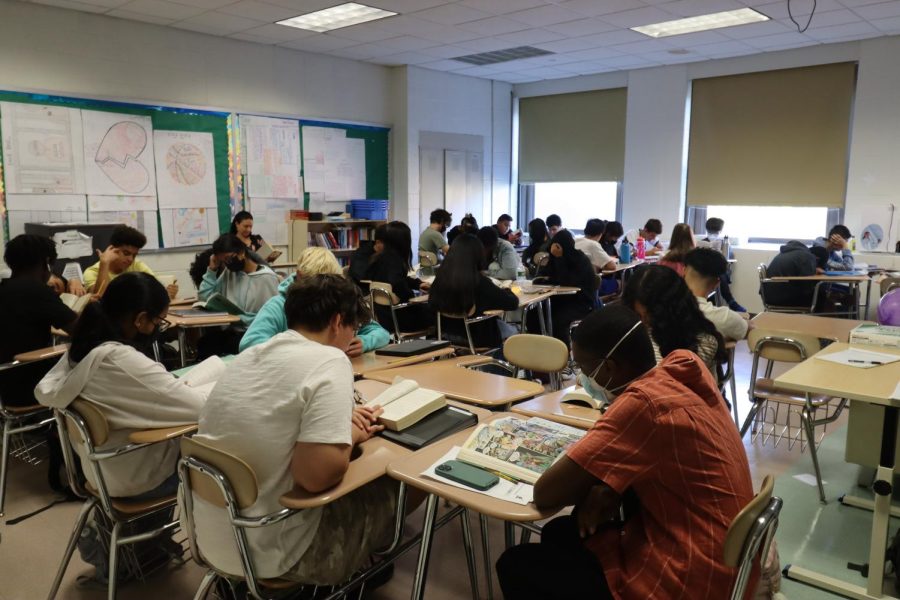
It has happened to many of us. You just received your new schedule for the spring semester and you’re sitting in your language class. Your eyes are staring wide open in confusion at the teacher and the board when you notice someone you had class with last semester. The anxiety, hopelessness, and ad nauseam are mirrored as you silently mouth to each other, “Do you understand this?” It’s the same class, but not the same teacher.
Multi-year courses build off of previous class knowledge. As such, basic principles established in Latin 1 and Spanish 1 are the fundamentals that are built on in later courses; AP World History tests students on knowledge from both years of the course. While it may seem like there isn’t a problem with multi-year courses, an issue does exist: the teachers. Before we go any further I’d like to clarify I am not blaming teachers, rather, I say the problem is having different teachers for multi-year courses.
Mandated two-year courses are more of a nuisance when students have to begin the new term with a different teacher. For these two- year courses, not all teachers leave off at the same point; some get further than others, which creates a problem when classes return in September. Not only do classes have to account for differing amounts of knowledge, students have to adjust to varied teaching styles. Rather than focusing on the content, students are wasting time trying to get adjusted to their new teacher, where more often than not idiosyncrasies prevail and things are done differently.
What is the solution to such problems? The answer lies in a concept called “looping.” Looping is a practice where the same teachers are kept for multi-year courses. If you had Mr. Martinez for Spanish 1, you would have him again for Spanish 3. Applying looping to the language classes and even the AP World classes in Townsend Harris will prevent the annual conundrums involving new teachers. Instead of teachers having to ask where everyone left off last year, they can get right into the teaching with students who are already comfortable with their methods. Besides, not all teachers teach the same way; some prefer drawn-out slideshows, while others prefer handouts. So why force students to re-adjust when the teaching can begin right away? Switching teachers after summer vacation or even mid year mid-year throws a wrench at the student learning machine.
There may be some doubts about the unknown concept of looping, seeing as it is practiced by a minority of schools, but cases in the United States have shown that schools that implement looping reap a variety of benefits. The Tolland Middle School in Connecticut saw an increase from 41% to 79% in writing competency scores from students who looped. The eighth grade students in looped classes had higher grades in language arts than students in non-looping classes. But grades weren’t the only benefits of looping. Joseph Rapp, the superintendent of the Attleboro, Massachusetts School System, had 26 elementary and middle school teachers move on with their students for two years. Over those two years, attendance rates in grades two through eight increased from 92% to 97.2%, while the teacher absence rate went down from 7 days to 3 days per year. In the Orchard Lake Middle school in Minnesota, looping was implemented for three years. A study found that the attendance rate, class averages, and student involvement in school activities all increased as a result of looping. Clearly the advantages of looping go far beyond saving time for the teachers in September.
Some will contend that locking in teachers for two years could lead to even worse performances, namely in cases where a student’s learning style and a teacher’s teaching style prove incompatible. This is easily remedied by having students requesting a class change from the guidance department. While it will require some action from the guidance office, setting up this sort of safety net will ensure that looping does not become a nightmare for students who may be struggling with certain teachers.
A multi-year course is more demanding than others. It contains more information for the students to remember, and asks them to remember it for a longer time. Does it really make sense to burden the students any further by forcing them to re-adjust every September? Implementing looping would save time, raise class averages, and ultimately lead to a better learning experience, things that I think both teachers and students can agree to.




























Andy Hua • Jan 9, 2014 at 8:46 pm
I’d also like to add, that with the way guidance functions, a simple class change is quite that simple. So while looping is a good idea in cases where it proves beneficial, it has too many drawbacks when it becomes detrimental.
I • Jan 8, 2014 at 10:33 pm
I definitely agree with this. I think your example with Mr. Martinez was great, because he was always known for teaching well ahead of others, only to get a class the next year with half the students being at his advanced levels, and half being behind. This resulted in him having to reteach the same material that half the students already knew. I think that looping could work, as long as there was an opt out, or a request at the end of the year, where if you think that you and a teacher are not compatible that you can elect to be switched out.
Zion Kim • Jan 8, 2014 at 7:14 pm
I agree that teacher consistency is necessary in a lot of cases, but what if the teacher who taught your first year of a class had a teaching method that wasn’t effective for you? If looping were implemented, it would mean that you would have the same teacher and experience the same struggles comprehending the material in class and no chance of getting a teacher who has a style that might fit you better. It’s a 50/50 chance with this system, and I’d like to know if there are any solutions for this potential problem.
Ivy • Jan 8, 2014 at 11:13 pm
Well, a class change could be requested for those that do not favor the teachers teaching style. I really agree with this article, because in AP world, we spend half the band catching up on information that only half of us learned in year one, and the other half complaining about how we weren’t taught the same things.